Our dog Baxter ran into something in the woods on our property a few months ago. (Fortunately, he wasn’t badly injured, and he’s completely recovered. You can read the whole story here.)
Our assumption is that he met up with a coyote.
Lindsay suggested that it might be helpful to share some tips about dog safety in coyote territory, so that’s what I’m doing today.
By understanding coyotes, we can better understand how they react to humans and dogs. (This article includes a picture of a dead coyote.)
This article includes info on:
- Coyote biology and behaviour
- Urban coyotes
- Coyote attacks on people (rare)
- Keeping dogs safe around coyotes
- How to scare or “haze” a coyote
- Myths about coyotes
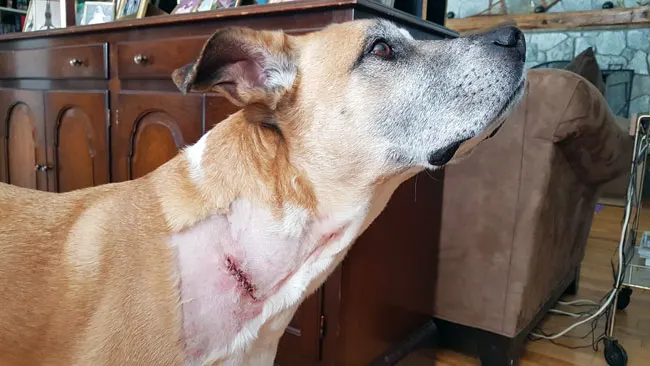
I reached out to Coyote Watch Canada, a not-for-profit community-based wildlife organization, and they provided me with lots of really helpful information for this article. I also spoke with CWC founder, Lesley Sampson.
How to Keep Your Dog Safe Around Coyotes
About coyotes
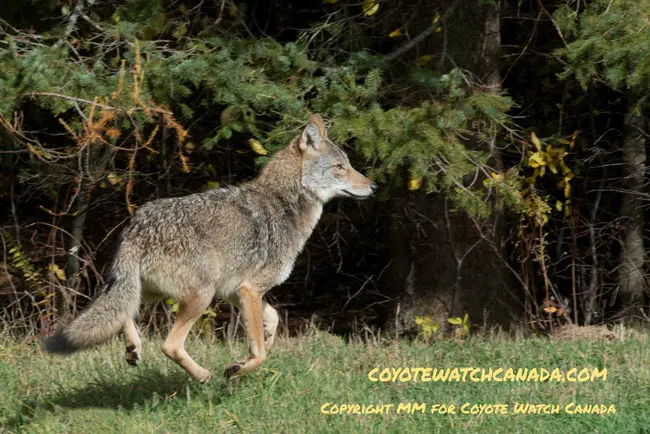
Coyotes live in most areas of North America. Their current range stretches from Panama, through Mexico and up to Northern Alaska, so many people have encountered or will encounter a coyote at some point.
At our farm, we usually hear coyotes at night and see their tracks during the day, but we very rarely see a coyote. However, that doesn’t mean they don’t see us (more on this below).
The average adult coyote weighs between 22 and 40 pounds. Their size both surprised me and reassured me. They are much smaller than I thought and about half of Baxter’s 60+ pounds, which evens the odds a bit for him, in my opinion.
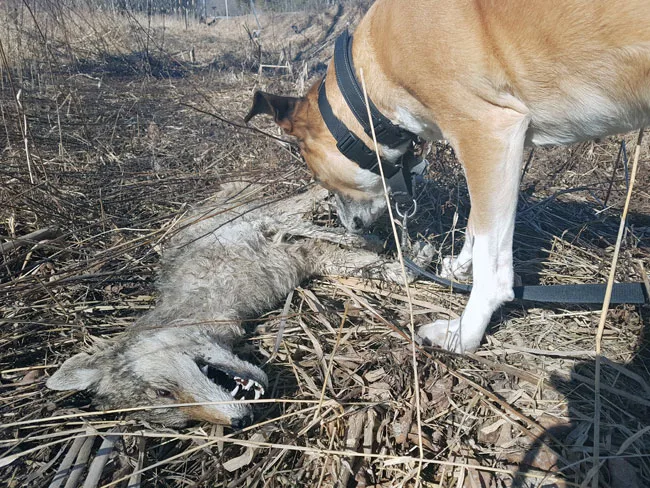
Coyotes can eat a variety of food. Their primary food sources include rodents, rabbits, squirrels and carrion. They also eat insects, fruit and grass. In cities, coyotes will eat pet food and garbage (specifics on urban coyotes below).
Coyotes live in a variety of areas, like forests, grasslands, deserts and mountains. However, coyotes are very adaptable and also live in many cities across North America.
A coyote’s year is divided into three main periods: breeding (January-April), pup-rearing (May-August) and dispersal (September-December).
Coyotes are considered a keystone species. They help to keep ecosystems healthy.
Coyote behavior
Coyotes normally avoid humans. However, intentional or unintentional feeding may change a coyote’s tolerance and they may begin to approach people or yards.
For example, some coyotes have learned that people (and their properties) will provide food, whether through feeding wildlife, garbage or compost bins, bird feeders which attract rodents and birds, or cat and dog food left outside.
Like many wild animals, coyotes are aware of everything in their territory. They will occasionally “escort” or “shadow” people if we walk through their territory (this behavior is especially common if there are pups).
If you see a coyote doing this, it can feel like you’re being stalked. In fact, you are most likely being monitored.
Coyotes live on their own, in pairs or in family units (aka packs). Every family is unique, but at the centre is a dominant breeding pair who mate for life.
Coyotes’ social situation may change throughout the year. For example siblings or older offspring may join the breeding pair to help raise pups.
Once the pups are grown, some may disperse and some may remain with the family. If one of the alpha pair dies, subordinate members will start breeding.
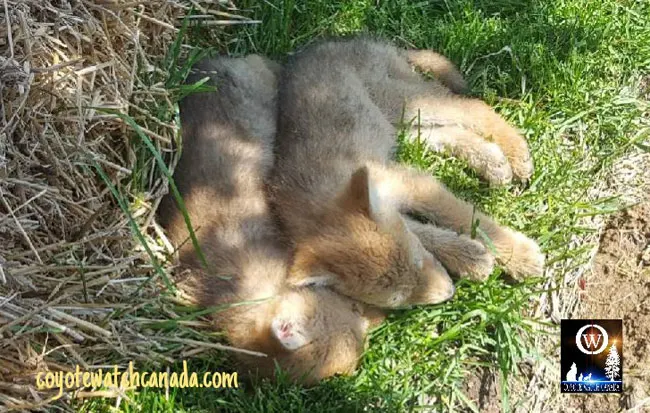
Along with breeding , other reasons coyote families may come together to form a pack include to defend their territory or collaborate to hunt for food.
Coyotes in urban areas
Coyotes have been part of urban areas for more than 100 years. But as human populations grow and natural areas decrease, encounters become more common.
Matthew Walker of the University of Manitoba prepared a report in 2015 on urban coyotes and strategies to manage and minimize conflict between coyotes and humans. Much of the information in this section comes from his study.
In cities, you will often find coyotes in industrial yards, cemeteries and golf courses—green spaces that see less human activity.
If coyotes substitute their natural diet with human food—readily available in cities—they may become more accustomed and less fearful around people. This in turn may increase the chance of humans and coyotes coming into conflict.
For example, following some coyote attacks here in Canada, partially digested human food was found in the coyotes’ stomachs and investigators uncovered that some residents in the area were feeding wildlife, which may have attracted and “tamed” the coyotes.
In the 1980s, there was an increase in complaints about coyotes in the Vancouver area.
“In response, [the city] implemented a rigorous coyote management strategy, which included monitoring, education, bylaws against wildlife feeding, and aversive conditioning techniques.” (I talk about “aversive conditioning techniques” or hazing below.)
Human-coyote conflicts significantly decreased.
Vancouver along with Niagara Falls are two cities where Matthew says there are a lot of coyote sightings, but little conflict. These cities show that “coyotes are capable of living in close proximity to people [and] posing little threat to human safety.”
Matthew interviewed a number of people over the course of his research, and many stressed the importance of educating people about how to co-exist with coyotes.
“Conflicts between humans and coyotes can pose a risk to human health and safety and often have negative consequences for wildlife.” Through education, many conflicts or negative encounters may be prevented.
Danger from coyotes for dogs and people
Coyotes elicit many strong emotions. However, people’s fear of coyotes or perception of their risk is often greater than the reality.
On our own property, Baxter is very confident and territorial—curiosity and a drive to explore is common in most dogs. He likes to follow scents and when we see wildlife he often wants to chase them.
Therefore, we usually keep him on a long leash for walks when we’re at home. However, on the day of his encounter, he was off leash.
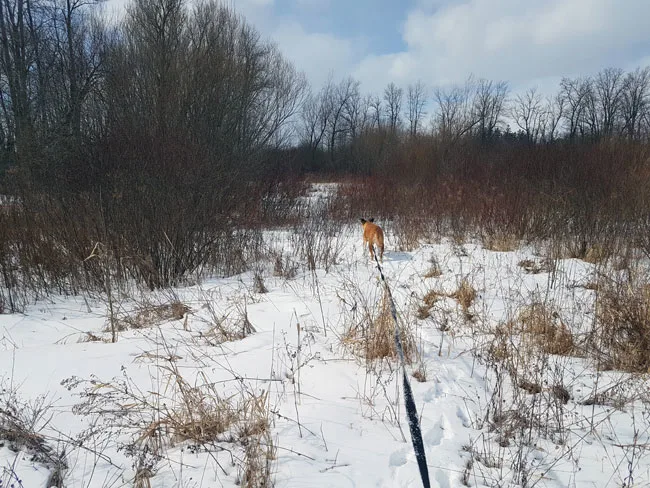
It’s likely that Baxter picked up a scent and followed the trail until he met up with the animal–which we assume was a coyote. Baxter was the invader and the coyote was the defender—natural behaviours on both sides.
Coyotes and other wildlife protect themselves and their families and may perceive domestic dogs as a threat. Depending on the size of your dog, the coyote may view your dog as food. Cats can be common prey for coyotes.
Coyote attacks on people
Coyote attacks on humans are very rare. However they have occurred throughout Canada and the United States. Between 1995 and 2010, on average less than 3 people were bitten by a coyote per year in Canada. There was one fatal attack in Canada in 2009 in a rural area of Nova Scotia.
In contrast to Canada, a larger number of coyote attacks have been recorded in the United States, particularly in Southern California. Between 1977 and 2004, there were 111 coyote attacks on humans in Southern California (about 4 per year).
Arizona and Nevada have also had a number of coyote attacks on humans. Many factors may be involved in these attacks, but high population densities are one likely explanation. Source
Coyotes do present real threats to humans and our pets beyond physical attacks. Urban coyotes in Canada may carry rabies, canine distemper virus, and canine adenovirus. Transmission can occur directly (through physical contact such as bites) or indirectly (through fecal deposits).
When we took Baxter to the vet after his encounter, one of their first steps was to check his vaccinations and update any shots that he needed. Disease transmission is an important consideration with coyotes.
Keeping dogs safe around coyotes
The biggest way to keep your dog safe is keep him on leash. 92% of conflict situations between wildlife and domestic dogs occur when dogs are off-leash. Source
I am a huge proponent of off-leash hiking with dogs and love being out in the woods with Baxter. However, since his injuries, he has been on leash any time we’re out on our property, even if we’re very close to the house.
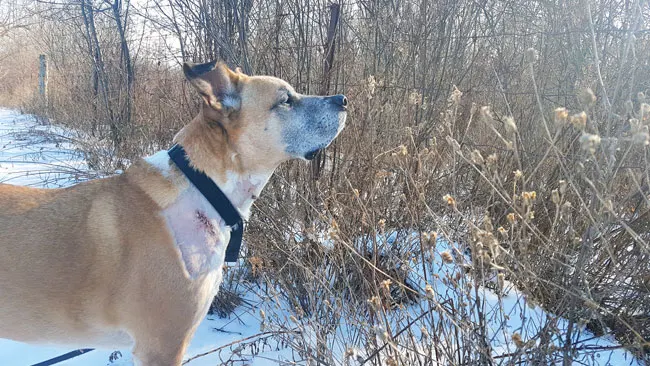
Following the encounter, we saw a coyote four times on our morning walks. He or she seems to be exhibiting the shadowing behaviour I mentioned above, so we assume that there may be a den somewhere on our property. Our strategy is to keep Baxter on leash and wait out the coyote(s).
In the seven years that we’ve lived at our farm, we’ve seen coyotes less than a dozen times. So we are hoping that once we’re through the breeding and den stage we will return to our usual peaceful, unseen co-existence.
Leashes are important for other reasons. Chasing or harassing wildlife is illegal in most areas, leads to conflict between species and alters the natural behaviours of wildlife. As well, off-leash dogs can encounter vehicles, traps, snares, poisons, sick animals or other dangers.
Along with keeping your dog on leash, there are other steps you can take to be safe around coyotes.
The most basic is to be aware of whether there are coyotes in your area. Watch and listen for signs of coyotes (poop, tracks, yips, howls) when you’re out with your dog. Follow wildlife or conservation organizations on social media, as they often post PSAs about local wildlife.
A leash does not negate the importance of excellent recall with your dog. An excited dog may pull the leash out of your hand, and you need to be able to capture his attention and get him to come to you.
Respect the regulations of the conservation areas or municipalities that you visit with your dog. From leash laws to littering to hours of operation, these rules are in place for reasons.
If you encounter a coyote, do not run. Keep your dog at your side and walk away calmly. If the coyote advance towards you, use one of the hazing tactics described below.
How to keep coyotes away from you and your dog
When coyotes are deemed to be a nuisance—or sometimes when they’re simply seen in an area—the solution is often lethal. The coyote is killed.
However, this approach may create additional problems. Removing a coyote from an area changes the social structure in the coyote population. If a member of the dominant breeding pair is killed, other pack members will start breeding, resulting in more pups being born.
Younger individuals may step in to fill the gap, and these coyotes may be less well socialized and more likely to pursue human food sources and territories closer to human populations.
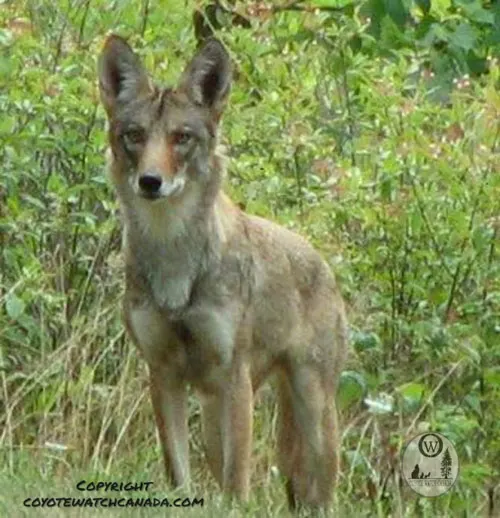
A better strategy is hazing. While hazing usually has a negative connotation, for wildlife it’s an approved technique (also called aversion conditioning) to discourage animals from associating humans with good things.
Used effectively, hazing can build such a negative association that wildlife, such as coyotes, foxes or wolves, may move away from humans.
Hazing is not new. It has been used successfully around the world with many species, including bears and tigers.
CWC says that “hazing can restore a coyote’s natural avoidance of humans and minimize interactions.” The charity has found that “communities that employ basic hazing techniques experience measurable results, while educating and empowering themselves.”
What to do if a coyote approaches you and your dog on a walk
You should attempt to scare or “haze” the coyote by:
- Making yourself big. Stand tall, wave your arms and shout (don’t scream) while stepping in the direction of coyote until he or she runs away
- Making noise. Use your voice, clap your hands, honk an air horn, bang pots and pans together, blow a whistle, shake a can filled with coins or pebbles, snap a plastic bag, make whatever “annoying” sound you have available.
- Tossing a projectile toward—not AT—the coyote. Use sticks, clumps of dirt, small rocks, a tennis ball, or spray a garden hose.
Coyotes that have never been hazed before may not run away immediately. Don’t stop until the coyote has completely left the area.
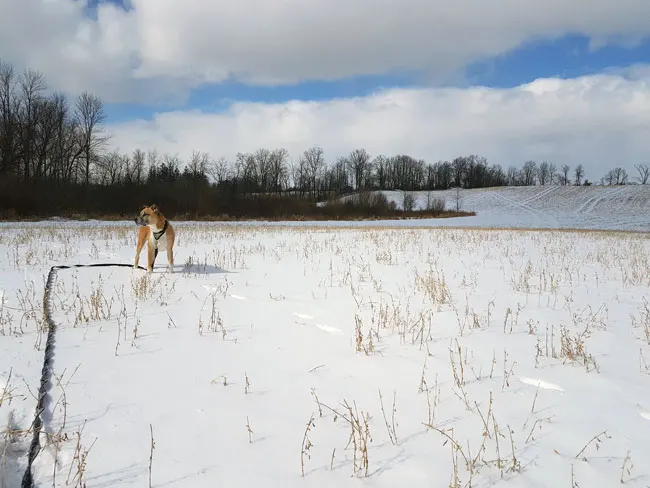
Several years ago, we had a coyote hanging around our property. One morning it shadowed Bax and I on our walk and when it got too close I shouted and waved my arms. It ran away, and I didn’t see it again.
Wildlife is part of our life in the country. And it’s something I love about our farm. I am very conscious that the coyotes were here long before us, and I feel that they have as much right to the land as we do.
Coyote Watch Canada’s stance is that education can increase acceptance and decrease conflict between humans and coyotes.
Changing human behavior—such as people being more careful about feeding wildlife, more cautious with their pets around coyotes, better about securing garbage and more knowledge about hazing techniques—is the most effective method for minimizing conflict.
I respect coyotes’ role in the ecosystem and hope that our whole family can co-exist safely and happily with all of the occupants of our farm. And I hope that this article helps you to do the same.
6 tips to keep your dog safe from coyotes
1. Keep your dog on a leash. Use a long leash to give your dog freedom.
2. Be aware of your surroundings. Listen for sounds of coyotes or watch out for tracks or poop. These are signs that you may be in established coyote territory or near a den site.
Watch your dog’s behaviour. I can usually tell from how Baxter is acting whether there is another animal in the area.
3. Have a solid recall with your dog. Coyotes can be a big distraction and a test of our recall training.
For example, if your dog picks up a scent, can you call him off the trail? Stop him from going into the woods? Or, the ultimate test, stop him from giving chase if you see a coyote?
4. Follow the rules. Obey signs, bylaws and regulations in the wild spaces you visit. Don’t litter, leave food waste or feed wildlife.
5. If you see a coyote, don’t move towards it. Keep a safe and respectful distance. If your dog is off leash, leash up, and keep your dog close to you. If your dog is small, you may want to pick it up.
6. Never run from a coyote. Leave the area slowly. If the coyote advances towards you or seems to be shadowing you, employ the hazing techniques above.
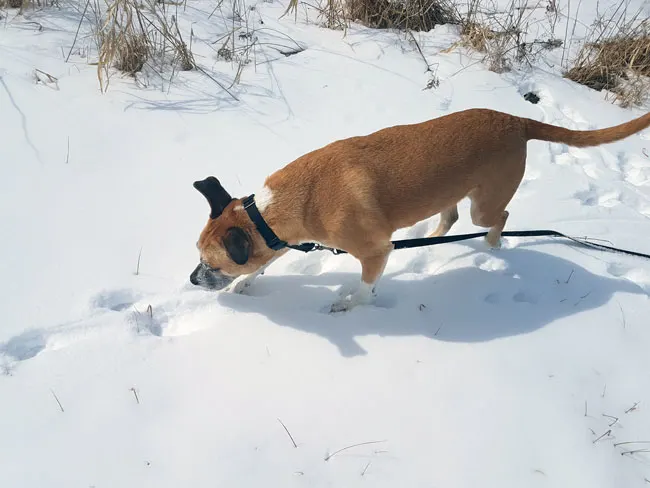
Coyote Myths by Coyote Watch Canada
Myth: Coyotes lure domestic dogs.
Fact: Coyotes are family oriented and do not use their family members to bait or lure other animals. When an off-leash dog chases a coyote, the coyote will flee to the safety of its family members. If a dog pursues, coyotes will defend their families.
Myth: A yipping coyote means it has killed something.
Fact: Coyotes do not advertise their food sources. Vocalizations are like a “Canid GPS”: coyotes yip, howl and bark to defend territory, locate family, celebrate, warn each other of danger and greet one another.
Myth: Coyotes have recently interbred with wolves, resulting in larger more aggressive “coywolves.”
Fact: “Coywolf” is a nickname for the Eastern Coyote, the one and only coyote species in Ontario. These coyotes share common ancestral DNA with the Western Coyote and Algonquin (Eastern) Wolf. The mixing of DNA occurred more than 100 years ago, and some remnant DNA still exists in Eastern Coyotes today.
Myth: Coyotes stalk people.
Fact: Coyotes are aware of everything in their territory. When raising families, coyotes will escort or shadow visitors travelling through shared spaces to make sure they leave the area.
Often misinterpreted as being “bold” or “brazen”, a curious coyote may stop and watch visitors to assess any threats to his or her family and make sure you leave the area. It is important to note that a coyote who has been fed by people may exhibit demand behaviour.
For everyone’s safety, never ever feed a coyote.
What about the rest of you? Have you ever encountered a coyote when walking with your dog?
Julia Preston writes for That Mutt about dog behavior and training, working dogs and life on her farm in Ontario, Canada. She has a sweet, laid-back boxer mix named Baxter. She is also a blogger at Home on 129 Acres where she writes about her adventures of country living and DIY renovating.

Jim
Friday 8th of November 2019
I walk my 55 lb unaltered male dog off-leash on the lane running the length of the family farm. He has good recall and usually stays very close, coming back frequently for a small reward.
However, twice in the last two years we have surprised a coyote in the open in a hay meadow, as we moved past the unharvested corn. Each time my dog has chased the coyote. I'm not happy that he does it and in the future will keep him on leash when it is close to dusk (at least until the corn is harvested and sight lines are open).
Both times, it was very obvious that the coyotes were unaware of us until we passed the end of the corn and saw them 50 yards away -- which shows that coyotes are not aware of everything in their surroundings -- because the coyotes were hunting mice in the hay meadow.
KL
Monday 22nd of April 2019
Thanks for this! Urban coyotes are becoming more common in Minneapolis-St. Paul, so I’m loving these tips.
Julia T.
Monday 22nd of April 2019
Glad you found this helpful. Thanks for commenting.
Diane & Anya
Friday 12th of April 2019
One thing you didn't mention was coyotes often carry rabies. That was the situation on the properties around where I lived in Waco, TX. They attacked several friends and neighbors dogs with horrible injuries. They were right up by their homes, workshops and barns. Same thing with skunks. I would never let my dog(s) out of my site in the area. It isn't worth the possibility they would be injured and or killed.
All the dogs survived, but it took along time to heal and the surgery and care required was very expensive.
Julia T.
Friday 12th of April 2019
Thanks for highlighting that. I did mention that coyotes may carry rabies, distemper and adenovirus. These diseases can be transmitted through feces as well as bites, so taking precautions like you do is important.
Chuck Taylor
Wednesday 10th of April 2019
All very interesting, however, I live in Glendale Arizona and walk my dog with two other individuals and we have seen coyotes a number of times. In fact my Dakotah has chased them thrice. I got pics twice. We have a desert area that we call the back 40 in which we walk our dogs. These coyotes have also been in our neighborhood. That was one of the times my Dakotah chased them. Shouldn't say them cause it was only one at a time. They are not agressive and have run off everytime.
Julia T.
Thursday 11th of April 2019
Thanks so much for sharing your experience. I'm glad to hear that they have run away and are not aggressive. It sounds like you have a healthy co-existence.
Sue
Tuesday 9th of April 2019
Excellent information, thank you
Julia T.
Tuesday 9th of April 2019
Thank you, Sue. I appreciate your comment.